
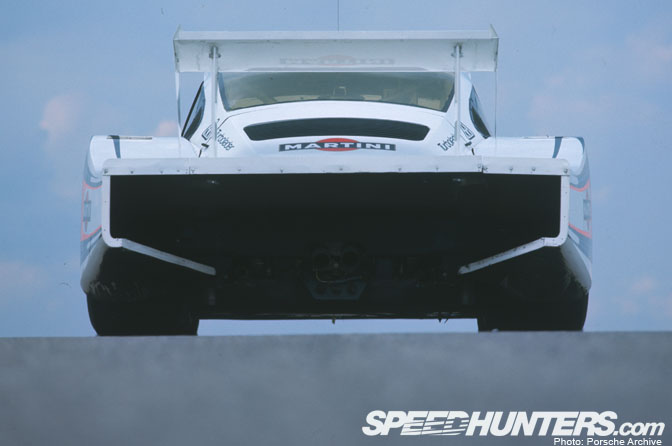
Please bring the 935," I wrote in my email to the Porsche representative; I very much wanted to see this famous machine up close and personal! "We'll get back to you about that," came the reply. Hmmm, didn't sound like it was going to happen!
Several months ago we started to communicate with Porsche about our plans to do a film and photography shoot at their Leipzig driving center in Germany. We had to choose which Porsches we would be making a set of Speedhunters car features about. The idea I put forward was to look at a cross section of iconic 911s; two production cars and two race cars. For the production cars we asked for the new GT2. It's a great example of modern Porschedesign excellence and we wanted to compare the GT2 against a vintage 911 performance machine; how about an old school Carrera RS?
For the race cars, we wanted to look at the late 90s GT1 race car, probably one of the more interesting design takes on a production based 911 chassis, and compare this against one of the crazy 1970s racing 911s… the 935 of course!
Having spent a good portion of my childhood and adult life looking at the story, stats and lineage of this famous racing machine I really wanted to see one again in the flesh and take the opportunity to point the NFS HD video camera in its direction. As much as I go on about Porsche 935s I haven't actually seen one in person since 1978!
Unfortunately it wasn't possible to get a 935 transported from from the Porsche HQ in Stuttgart to Leipzig. Seems like they are all undergoing a restoration project at the moment… Baaa… Oh well… We received a 1974 911 RSR Turbo instead, which was an honour in itself to shoot… You've seen John Brooks' fantastic article on this car, right?
For now let's have a look at the 935; a car which dominated much of European and American GT racing from 1976 to 1982, and seems to take up a high percentage of my automotive thoughts!
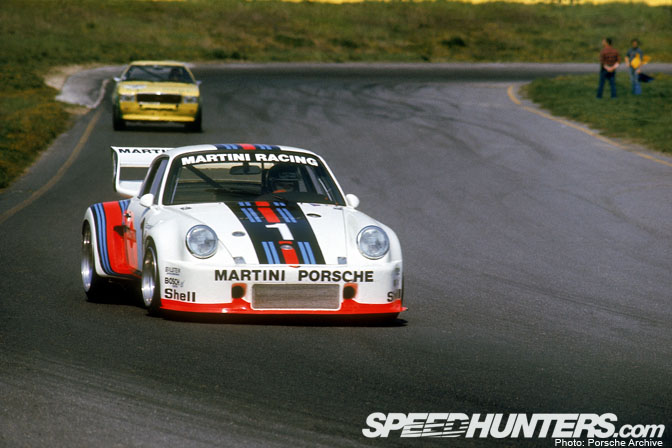
Here is the car that started it all: the first factory 935, referred to as the 935/76. It was built to compete in the then new Group 5 category for the 1976 World Championship of Makes. The CSI organization (the predecessor to the FIA) had created a new class for GT cars which allowed considerable scope for the modifications provided that the basic silhouette of the car remain unchanged when viewed from the front. The new category created considerable interest from several manufacturers but it was Porsche and BMW who stepped up to the plate with newly engineered cars for 1976.
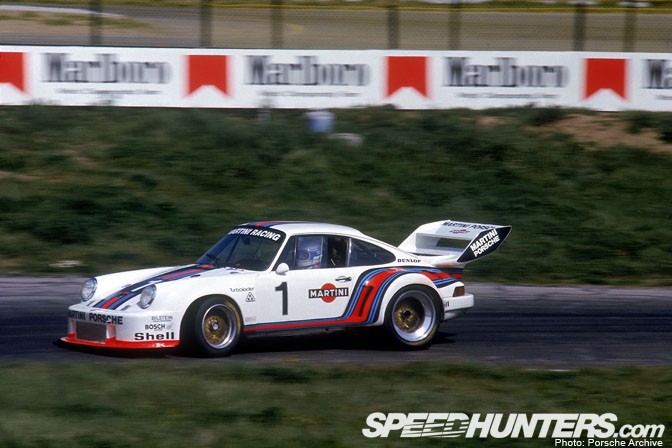
The first 935/76 ran to a swept volume of 2.8 liters, utilizing a single turbo with an adjustable cockpit mounted boost knob. At 1.2 bars the engine produced 550bhp; very good for endurance races like Le Mans. For sprint races such as Watkins Glen or Dijon, the car was run with 1.5 bars of boost, taking power up to over 630 bhp.
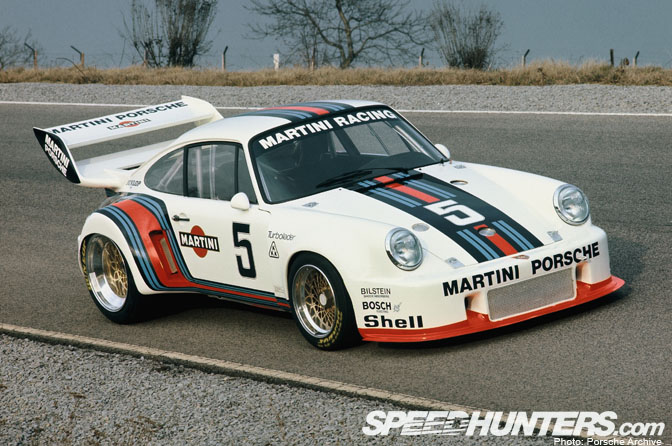
The above picture was taken as the car was first shown to the press in early 1976. You can see it still resembles something like a street 911 at this stage, yes? That would all change very quickly as the boundaries of the Group 5 rules were explored and then pushed.
The look of the car is dominated by the huge rear tires. Group 5 cars were restricted to 15 inch wide rear wheels. To overcome this restriction 19 inch rear wheels were fitted, thus increasing the rubber contact patch with the road. Think about that next time someone tells you that proper performance cars don't run big wheels huh?
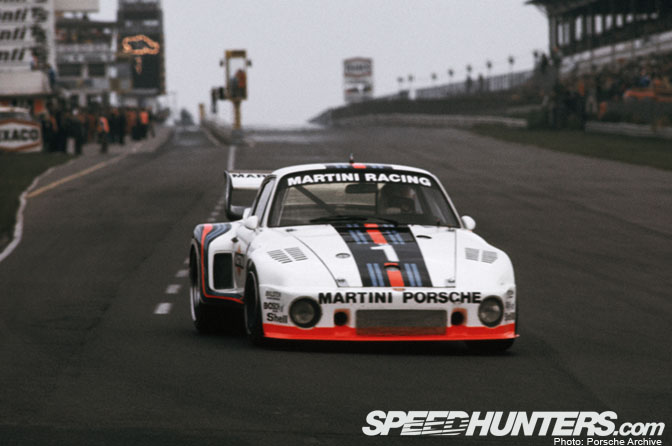
You can see that by the time this picture was taken, at the Nurburgring round of the 1976 World Championship, the car has gone through a bit of a visual metamorphosis. Famous Porsche engineer, Norbert Singer exposed a loophole in the rulebook (the first of many) that allowed him to remove the front headlights. In the Group 5 rules it stated that the fender area was free with the intension that teams would modify the bodiwork to fit their mega-wide race tires. Norbert decided that the headlights were part of the front fenders and promptly removed the production headlights and relocated them to the front bumpers. Nice one. The rear fenders were also reworked and extended to develop additional downforce.
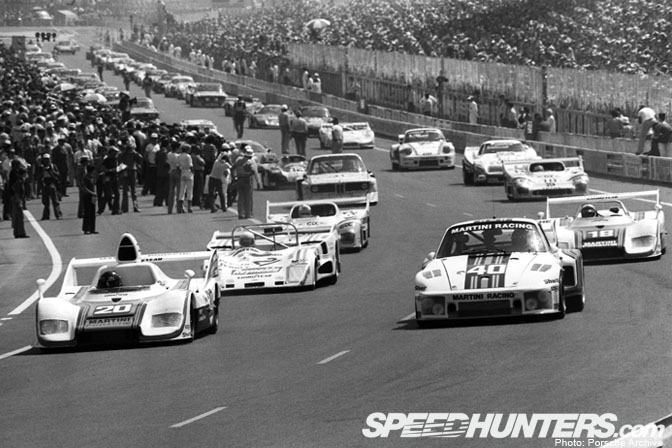
The 935/76 had a great debut at Le Mans in 1976 taking 4th overall and top honours in the Group 5 category. It raced among the front runners until a serious tire puncture followed by turbo problems tharted its efforts. In this picture from the formation lap, the sole 935 is starting well among the prototypes, quite far ahead of its other Group 5 rivals.
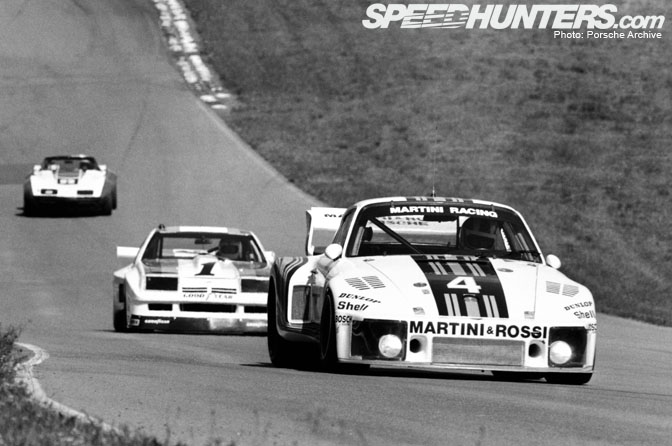
This picture was taken at the Watkins Glen round of the 1976 World Championship, towards the end of the season. Here, the 935 took the top spot as driven by Strommelen and Schurti with the second chassis, piloted by Ickx and Mass finishing third overall.
Road & Track magazine tested the 935/76 that year and listed the car has having a 0-60 time of 3.3 seconds. It covered the 1/4 mile with an astonding time of 8.9 seconds! The season ended with Porsche winning the World Championship of Makes, defeating their arch rivals BMW and their turbo charged CSLs.
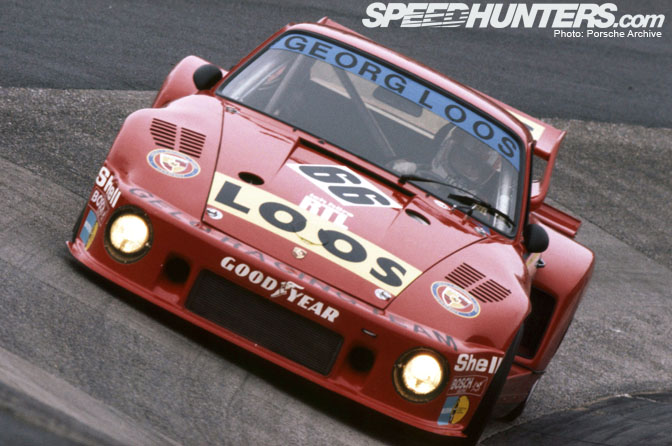
For the 1977 season, Porsche built thirteen single turbo customers cars. These were eagerly snapped up by the privateer racing teams and quickly came to start the 935's domination of GT racing for the next five racing seasons. The cars were almost identical to the factory 935/76, save an improved intercooler system. A new larger 3.0L displacement engine was also offered as an option.
The above car was the first of many 935s run by the German team owner, George Loos. It's seen here on the famous Karossel corner on the Nurburgring Nordeschliefe. For 1977, the car was normally driven by Rolf Stommelen.
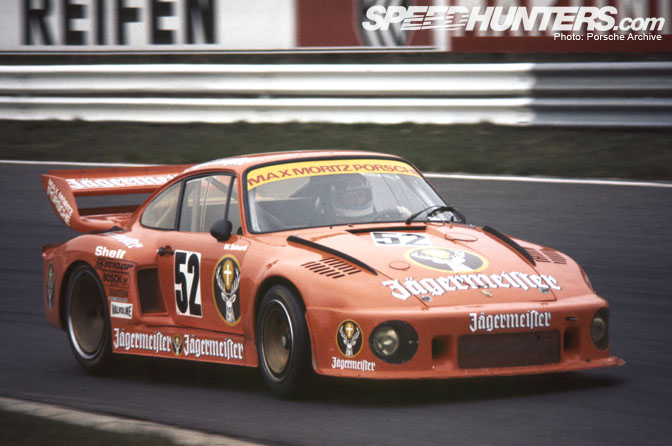
Another well known 935 from the original batch of 1977 customer cars was the Jagermeister sponsored machine, driven by ex-works driver Manfred Schurti in the German DRM National GT series. This car was later sold to someone in the USA and ran in the IMSA series for the 1978 season as the red Momo 935.
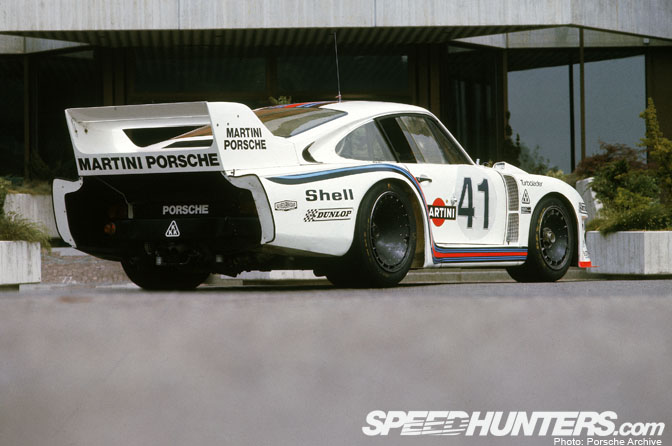
For the 1977 World Championship season, Porsche raised the bar considerably when they produced the 935/77. The car featured new high downforce bodywork, which added a second plexiglass rear window above the original item, thus allowing the air to sweep along the raised roofline more efficiently to the rear wing. This new way of thinking pushed the rules of the Group 5 formula, although there was nothing specifially in the regulations which forbade such modifications to the silhouette.
The flipouts you see on the side of the rear fenders served to decrease drag and increase downforce.
Have a look in front of the number 41 – the mirrors have been integrated into the body work. This feature was not particularly popular with the drivers!
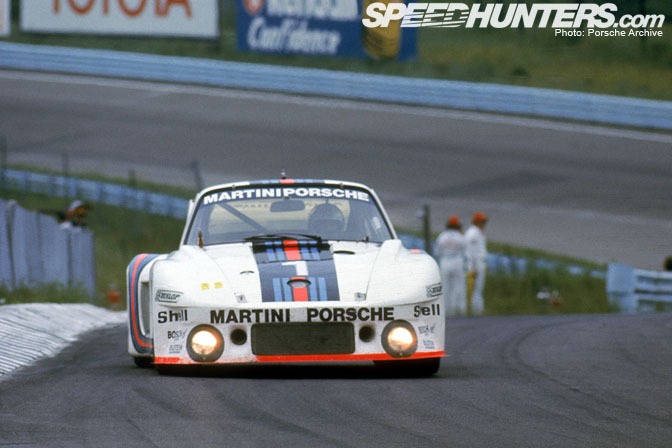
One real area of advancement for the 935/77 was the switch to two smaller turbos, from the larger single turbo of the 1976 car. This heavily reduced the amount of turbo lag experienced by the drivers, with improved throttle response. Power increased to 630 bhp at 7900 rpm.
Recognize the famous pale blue guardrails of Watkins Glen in the background?
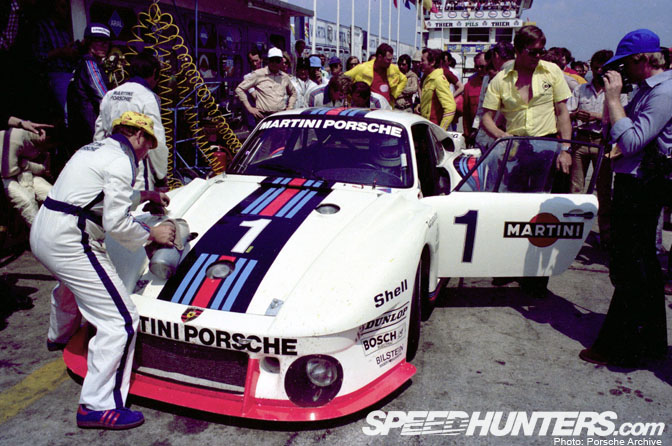
Nothing could touch the 935/77 during the 1977 championship season. The Porsches were world champions for the second year running.
By the end of the 1977 demand started to rise among Porsche's customers for access to some of the new developments. To this end, Porsche built a run of fifteen twin turbo customer cars, each with the same specification engine as the 935/77. Outwardly they looked very similar to the 1976 spec cars.
The 935 was now THE only privateer car to have in international GT racing, and started to rack up victory after victory across the planet. The development of this car marked one of the first truly successful customer racing programs, a tradition that Porsche continues with today.
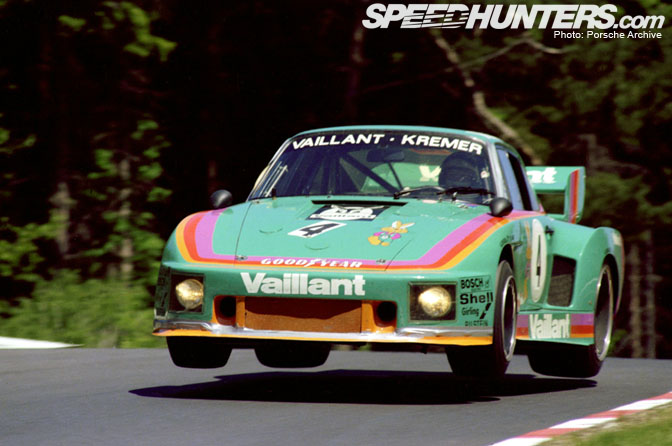
It's worth noting that there was one German 935 team that was not content to simply setup and drive the 935s out of the box. Cologne's Kremer brothers had their own ideas about developing the basic 935 DNA and in 1977 produced this variant called the K2.
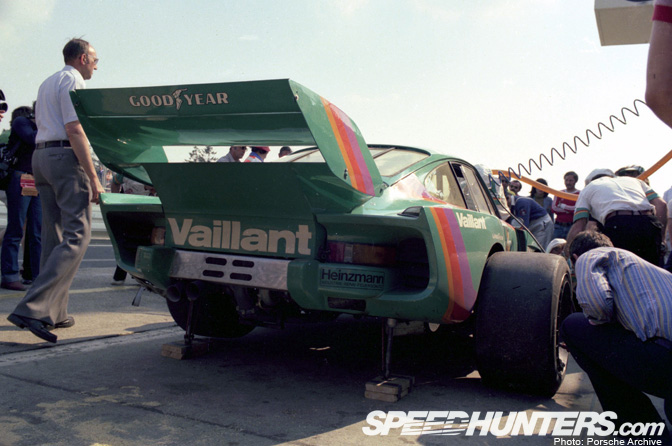
Of note are the fins along the rear fenders which were designed to increase downforce. The car had a great season in 1977, winning many national level races across Germany that year. Keep note of the Kremer team and some of the design details of this car, as they would later lead much of the development of the 935 in the coming years.
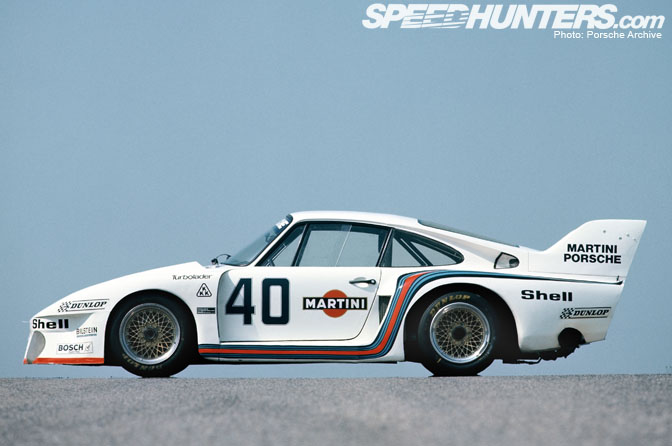
For the 1977 season, Porsche had very little in the way of serious competition from other manufacturers, so they sought to find new racing challenges inside the Group 5 category. They came up with the idea of building a car to race in the national German DRM series under 2 liter class – a stomping ground for BMW 320s and Ford Escorts.
Since it ran in an under 2 liter class, a newer, smaller motor needed to be built to keep in line with the rules of the class. With the turbo equivalency formula of 1.4, this meant the car (which was nicknamed "the 935 Baby") needed to be built with a 1.4 liter motor to a target weight of 735kg – far less than the 970 kg of the 935/77. The steel floor and front/rear bulkheads were cut from the car and replaced by an aluminum cage, creating an essentially tube framed chassis. At the time, this was quite a radical bit of race car engineering for a GT.
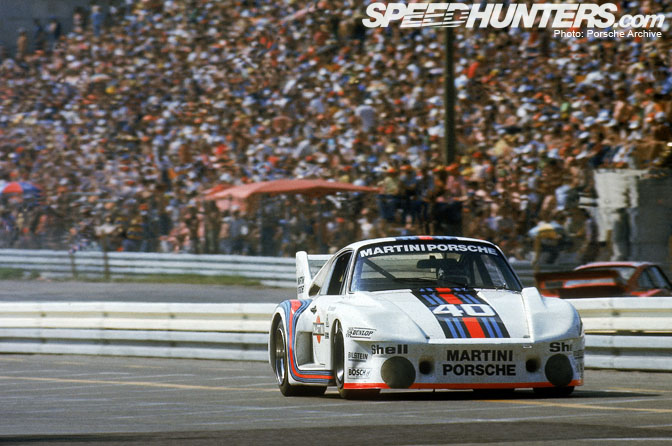
The car debuted at the Norisring DRM sprint race, but it was too new to make a strong mark, and its driver Jacky Ickx retired from the race, suffering from heat exhaustion. The Baby was then taken back to the factory for a quick development program in preparation for the German GP support race to be held at Hockenheim three weeks later. Fortunately, the hard work paid off and Ickx walked away with a 51 second victory over the competition. Porsche had proved their point over BMW and Ford and the 935 "Baby" was retired to the Porsche Museum.
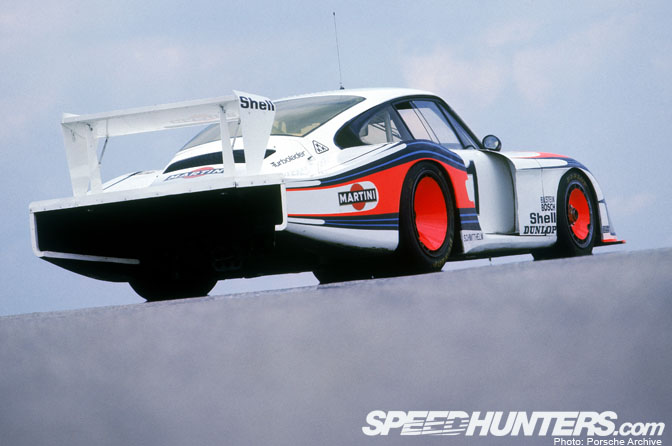
For 1978 Porsche built what is now considered the ultimate 935 race car, the 935/78 or Moby D-i-c-k (again, sorry, I had to add the dashs to make the word appear in the blog). The nick name itself comes from the look of the extreme long tail, which gave the look of a whale to some observers of the car.
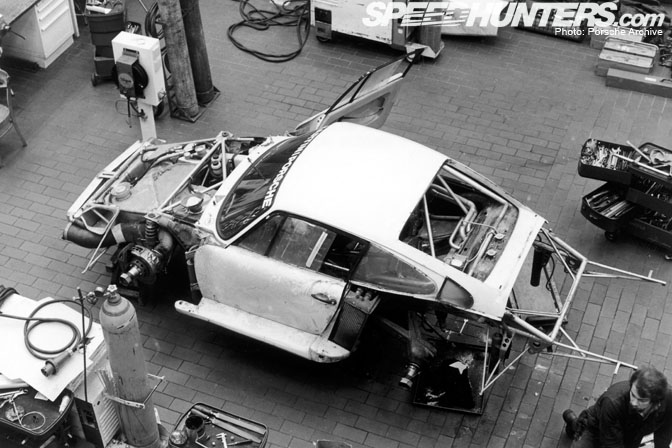
The car was constructed using the same aluminium space frame concept first seem on the 935 Baby. You can see it taking form in here in the Porsche workshops.
The chassis was more than 40 percent stiffer than the 935/76.
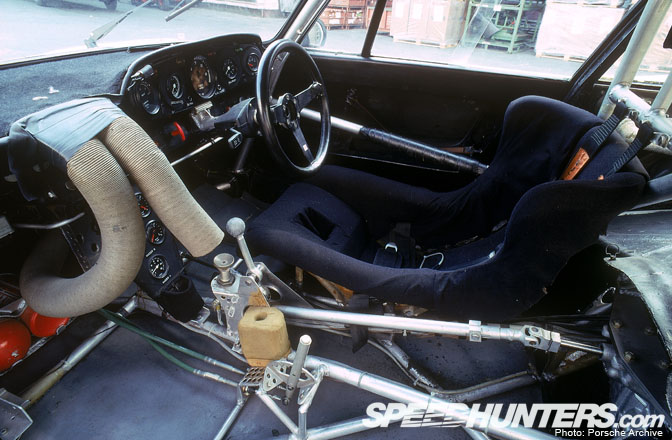
You can see in the above photo that the entire floor has been cut away and replaced with an aluminium belly pan.
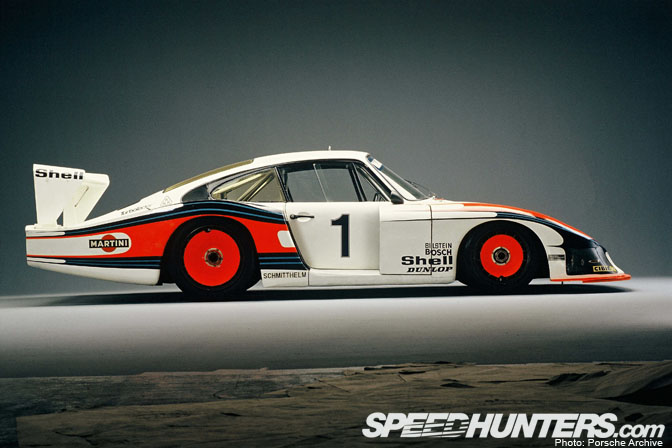
At the time the car was considered to be a very extreme and radical. Part of this feeling came from a new layer of imaginative thinking from Norbert Singer. The previous year, some new rule changes came in, with the aim of helping BMW and Ford remain competitive with Porsche. BMW complained they could not make their CSL low enough, simply because the side exhaust under the car forced them to run the car with a high ride height. So a rule provision came in allowing Group 5 cars to run with a raised floor, more with the intention of allowing exhaust clearance for front engined cars more than anything else.
However, Norbert used this new rule in a different way: he simply
raised the entire floor of the 935/78 and lowered the whole car down by
60mm, creating a very radical profile. This placed the top of the rear
tires just under the bottom of the rear windows! To cope with this low stance, the Porsche engineers flipped the
transmission upside down to reduce the angle of the drive shafts, in an
effort to improve wear and tear on the CV joints.
In scanning the rule book, Norbert Singer also noticed there was no set
regulation for how long the front of the car needed to be. He took
advantage of this to make a long and low nose profile to match the
car's long tail configuration resulting in a very slippery
low drag shape. Perhaps an overall win at Le Mans was in order?
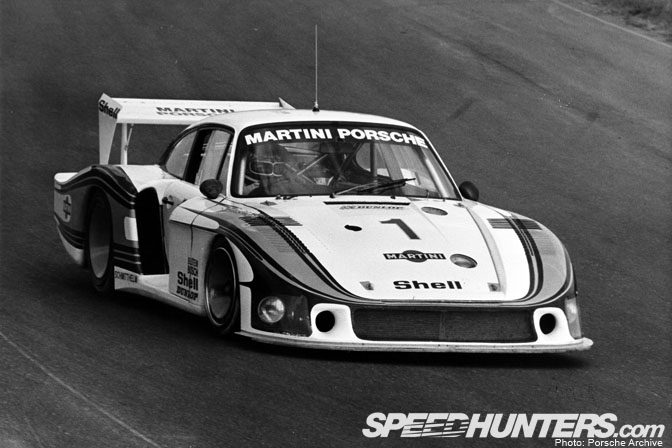
Seen above, the car debuted at the 1978 Silverstone 6 hours event and absolutely decimated its competition. It qualified on pole by a clear 2 seconds and won the race by 7 laps! Pure domination!
Check out Jacky Ickx's signature twin eye helmet through the wind screen.
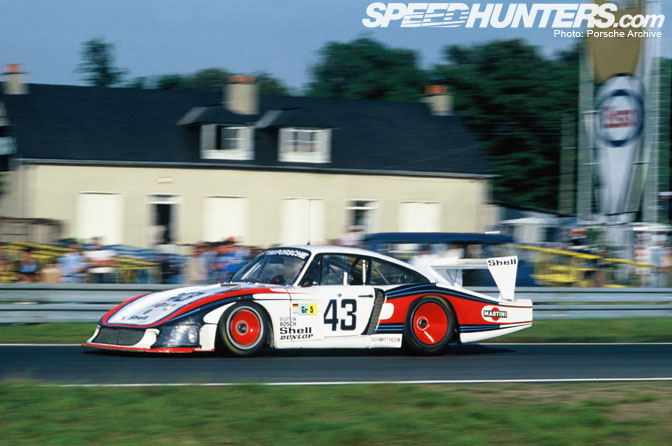
As the Moby arrived at Le Mans, expectations were high. It was developing over 750 bhp from its new water cooled, 4 valves per cylinder development engine, and was proving to be very slippery through the air. On the world famous 3km long Mulsanne straight it was clocked at an amazing 366 kph or 227 mph! Crazy!
However a general feeling of disappointment set in as the new engine proved to be very thirsty, and the team realized that it could only do 10-11 laps per stint with the car's 120L fuel tank. This would effectively take the Moby out of the running for Le Mans victory.
The car had a horrid race and suffered a myriad of technical problems; eventually finishing 8th overall.
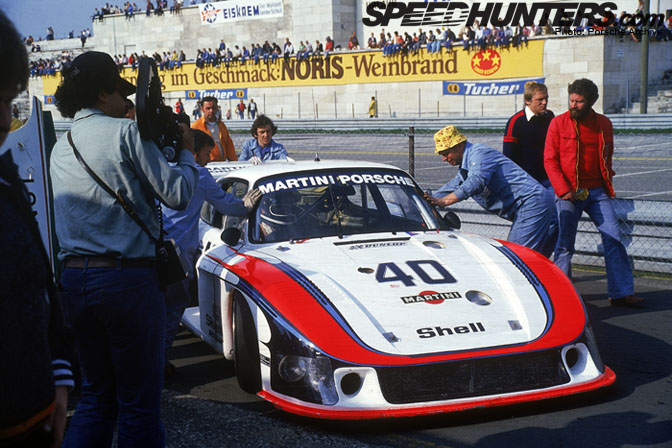
Nonetheless, it was clear there was no serious competition for the Moby in Group 5 and the factory elected to only run two more races with the 935/78 so as to allow their racing customers to carry the Porsche mantle. It lead both races (Norisring and Vallelunga) but retired in both cases.
The above photo is a super-rare snap from the car's last race at the Norisring in 1978.
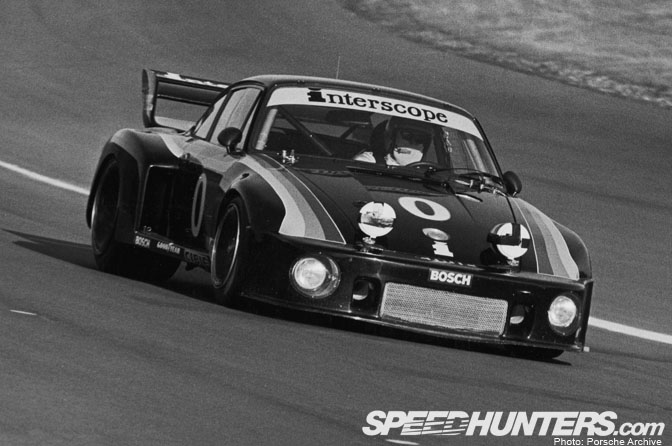
After 1978 the Porsche factory put its 935 race program to rest and focused their efforts elsewhere. It was now up to the Porsche customers to lead the way and in this regard, they were a flying success.
1979 started out with Ted Field's Interscope race team taking victory at the Daytona 24 hours in their brand new 935 customer car. The founder of Interscope Records shared the car with Hurley Haywood and famed ex-drag racer Danny Onglais.
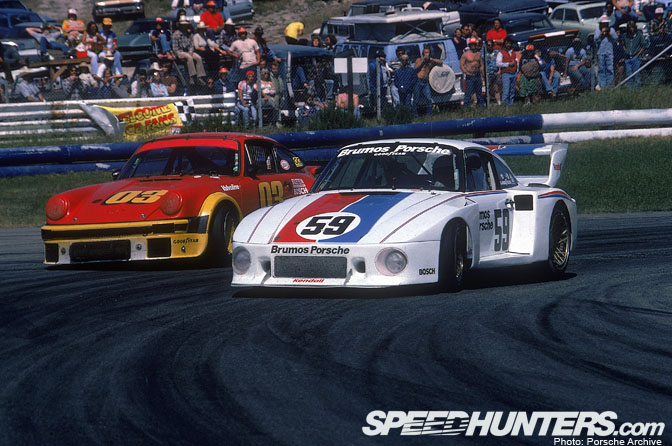
Another top performer in 1979 was the late Peter Gregg, probably the most famous American Porsche racer ever. He took the unconventional route of sticking with a single turbo setup, opting to run with the weight breaks this set up allowed. With this chassis he took wins at Road Atlanta , Laguna Seca, Lime Rock, Brainerd, Mid Ohio, Road America, Sears Point (as Infineon was then called), and Portland; quite a season of domination.
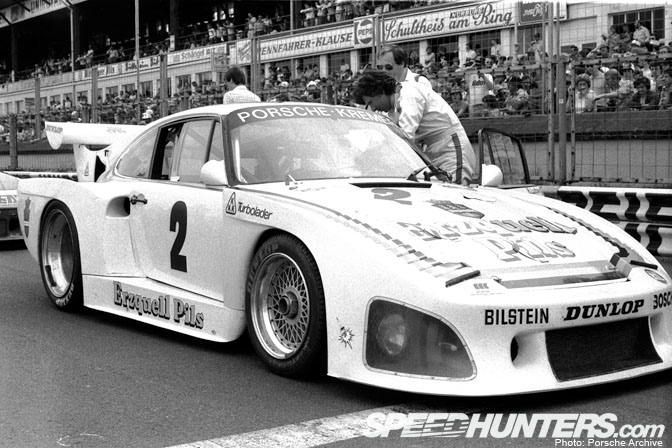
Remember the Kremer bothers and their customized 935 K2? In 1979 they debuted their new weapon: the Kremer K3. Like the Moby 935/78 of the previous year, it featured a full roll cage structure tying together the suspension points as well as the trick upside-down transmission, which allowed the height of the car to be lowered.
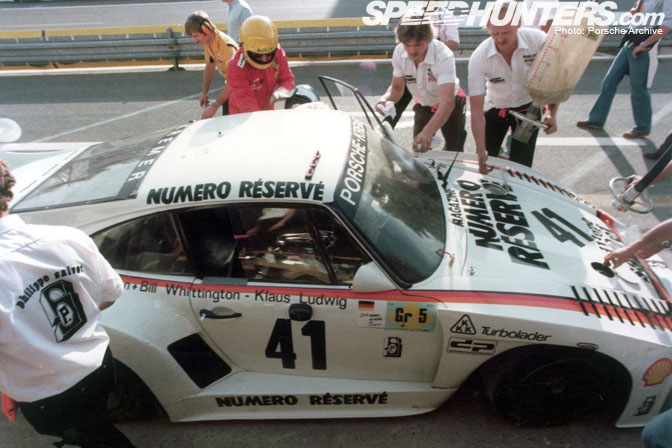
The car also featured a high down-force aero style with ridges along the bodywork used to direct air to the various aero components and intake elements. One secret to the car's success was its air-to-air intake system which allowed the car to develop a reliable 720 bhp over the course of a race; it could handle higher power without overheating, unlike the standard customer 935s.
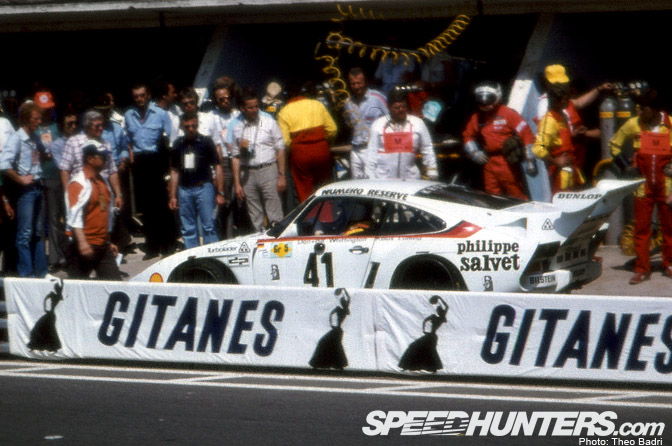
The Kremer K3 took the overall victory at Le Mans that year, an amazing feat for a mass production based car. I really doubt this could ever happen again unless GTs are allowed to become the primary class at Le Mans.
We'll leave the story there for now. In the next installment of the 935 retrospective I'll look at the final years of GT domination for the car from 1980 to 82 and the coming of the 935 specials.
:Rod Chong






Wow, a beautiful article!!! My favorite so far!
Great feature Rod. The Kremer car in mid air is a fantastic photograh.
What about a feature on the Zakspeed Capri and Mustang of the similar era?
It's posts like these that make me forgive Speedhunters' affiliation with EA. I already had most of the 935 pics in my archive, but I appreciate the new ones greatly!
Thanks, guys, for actually doing some outside-the-box journalism. That's the kind of pioneer ballsy reports that apparently used to exist up until the late eighties, when the demands of the US market drowned the international car scene in crap.Good choice on which models to feature too, can't wait for part 2!
~domi
Amazing article!!! I only remember this car from tin toys that were around when I was in elementary school. I only got into GT cars a little before the debut of the 1995 Porsche GT1, which really stretched the GT rules of that era (really a prototype). Thanks for the great history lesson!!!
Oh man, so much history! Great article, this is porn + education!
So much epic!
Hi guys! This blog is really cool, as I am mad about JDM.
I think that the first porsches you show in this post is a 934, which was made while porsche was still working on its 935, when the 930 has just been released on the market.
Ah Moby Dick, a legend on it's own
Was this the same Porshe that 'Jazz' from Transformers (the 80's cartoon) was modeled on!?!?!
I think it was!
Duuumm dimm , dumm di dammm , dum didadammm dammm dammmm....


Oooooops ! sorry , i use to sing alone when i feel good !
Grazzie mille ROD amico mio
Ho , btw , if ever you feel the need to share some pics of your " secret CD" , you know where to find me hehe
Foooorza 935 !
Rod, I enjoyed John's article and this one as part of Porsche month. It sounds like it's all done, but please tell me the late-90's GT1 is the 1998 car. Purely aesthetically speaking the '96-'97 cars do nothing for me but the 1998 that won LeMans is a great car with a great story and defines sex on wheels besides being the ultimate evolution of the 911 as of now.
wow...someone deleted my post
Ever heard the saying, "Man plans and God laughs"? Well sometimes this can be very true. You
amazing article, super-interesting and very well written - thumbs up for this one!
an article of the GT1 it would be fantastic!
but in internet are much information about the 98 one
so an article of the early GT1
would be more "explosive"
Hashiriya states the first pics in the article are that of a 934. They are not, as the first 935's had a conventional headlight setup. The 934 had bolt-on fender extensions and different bodywork from the 935.
An excellent article overall!
[View:http://www.youtube.com/watch?v=KXLs7XDtmAU] I know, I know.... I'm a bit obsessed with Porsche
Wow this 935 feature is turning into quite the epic Speedhunters article…. I originally only planned
Every so often we receive emails from young people asking for advice in their careers. How does one become